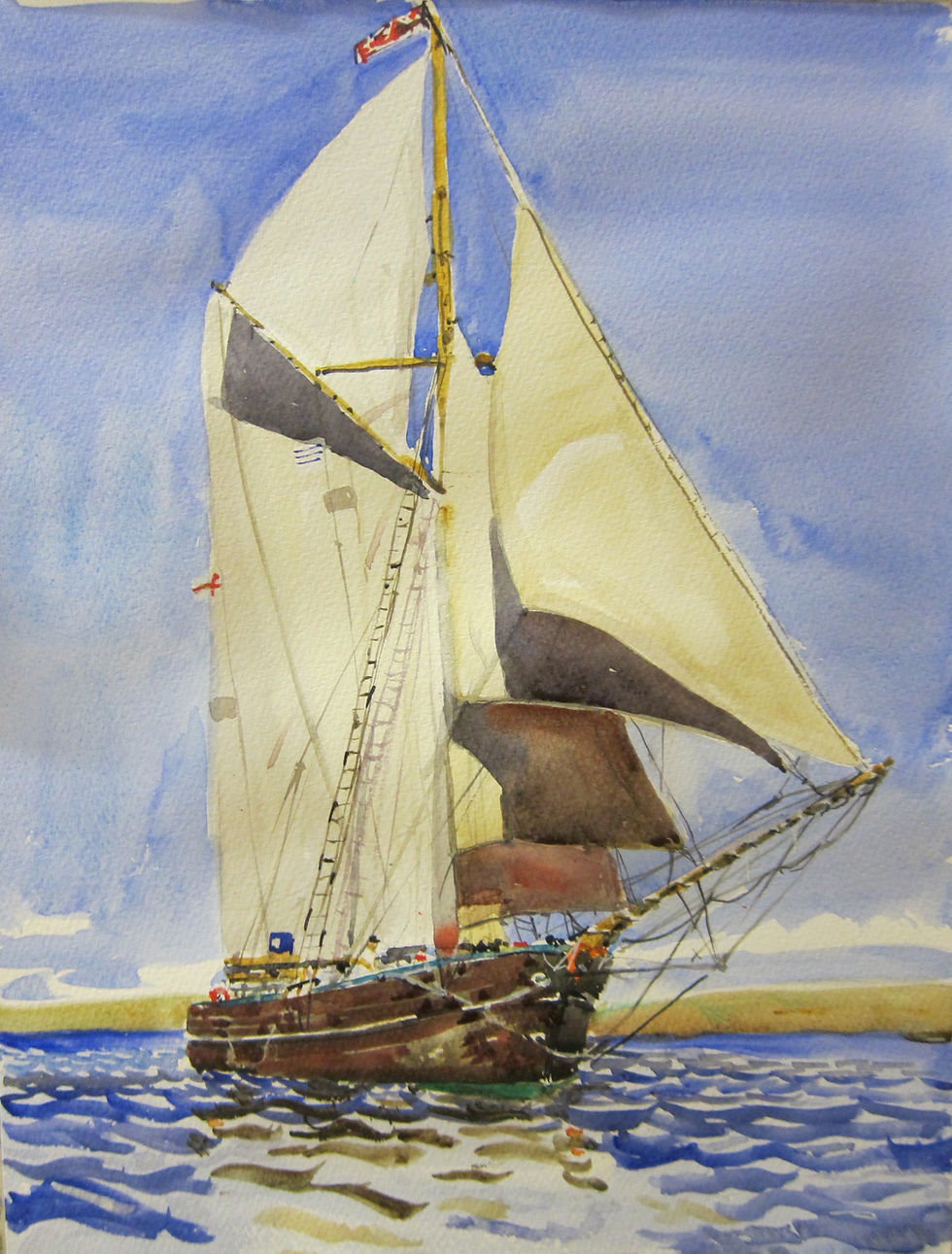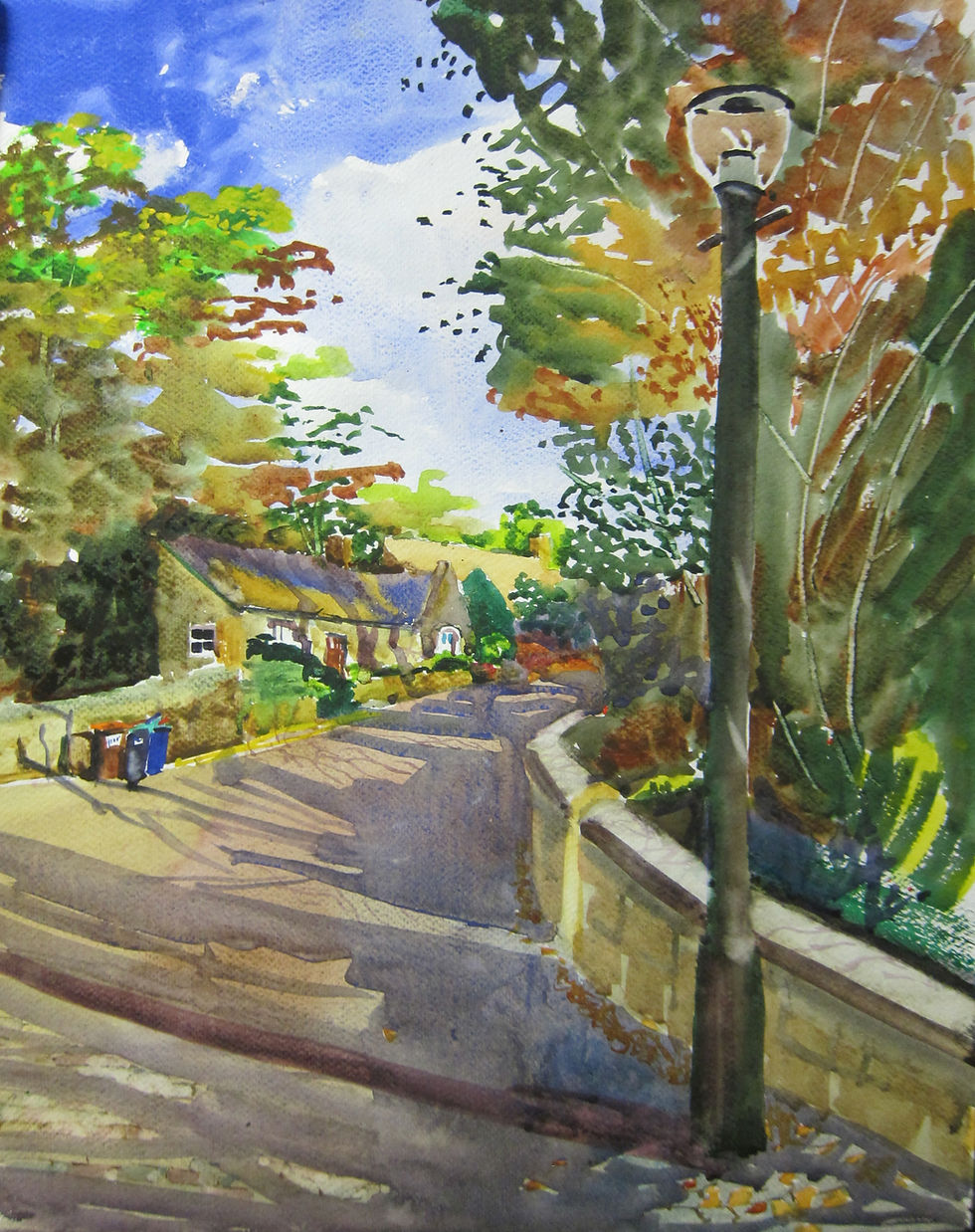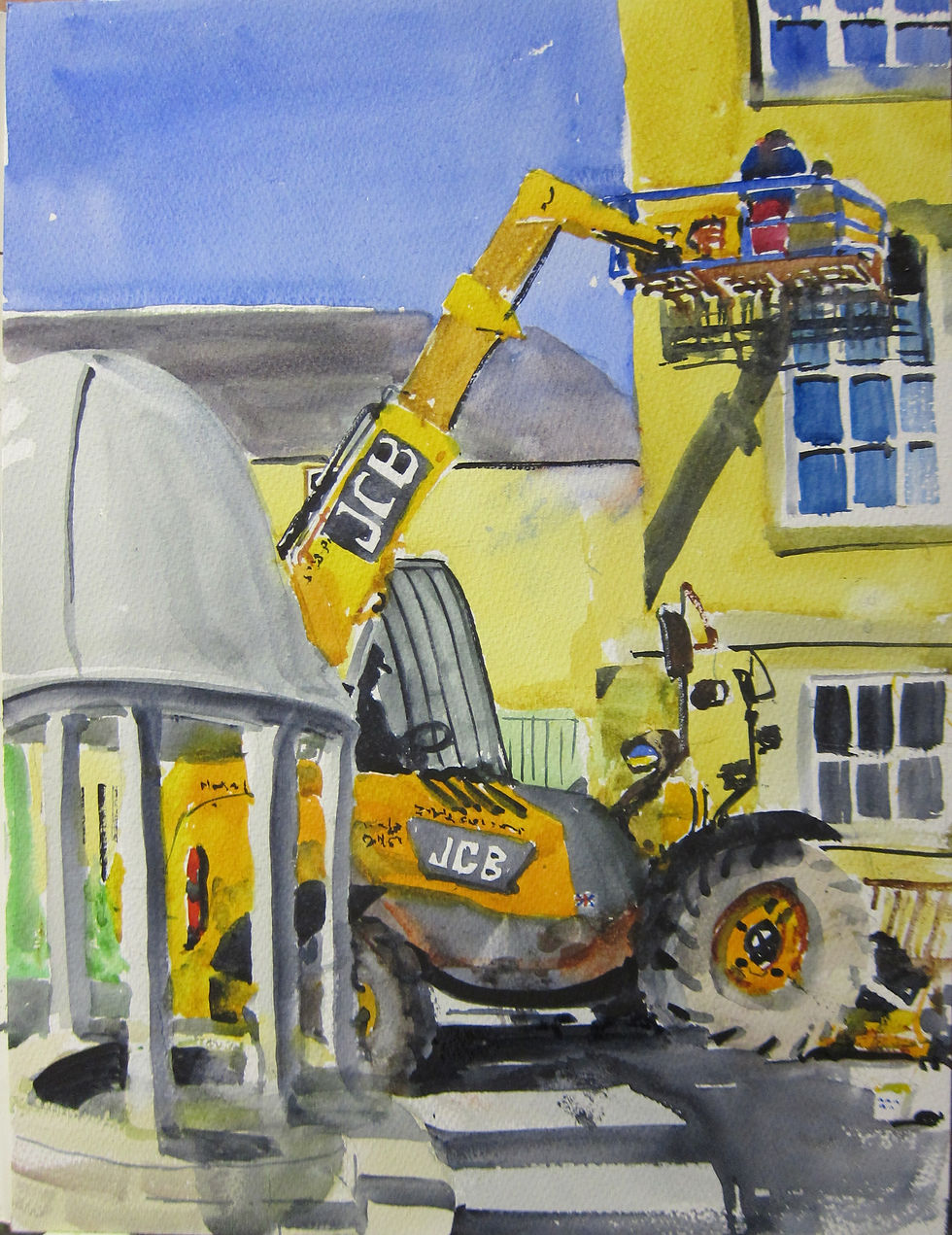Loosening Up
- Danny McShane

- Sep 2
- 8 min read
Updated: Sep 3
I frequently have chats about loose painting while out and about, painting plein air, often with folk who tell me they’d like to loosen up, and this post has the gist of how the conversation usually goes. I'm not by any means an expert, but I do happily paint loosely, or so I'm often told. Looseness isn't necessarily a desirable quality, nor always a good thing, but if you like the idea of it and have wondered how to paint more loosely than you currently do, this is the advice I'd offer.

Characteristics of loose painting
I understand ‘loose’ used to be an art school negative term, as in “you need to tighten up”, but tastes and fashions shift and now looser painting is very popular. While there’s no hard and fast definition, the attractive kind of looseness might be (loosely?) thought of as not photorealistic, not abstract, not overly detailed, confident, carefree looking but not careless, obviously painted, showing brushwork or even construction lines, impressionistic rather than slavishly realistic or (and I like this word for it ) “painterly” ie ‘like a painter did it’. Loose paintings are not going to be mistaken for photos.

A typical loose painting (or at least my favourite type of loose painting) might have minimal brushwork, freehand outlines, suggested detail, and look like it was painted effortlessly. It won’t look overworked or fretted over but tend to evoke a relaxed feeling.
The paradox of loose paintings is that they are not necessarily easier to paint than realistic paintings. This really surprised me starting out. I found I was getting reasonable results following realist painting methods (though some would consider my maximum level of realism still loose -it’s a sliding scale) but I found painting in a more direct freehand way much more enjoyable and also much more difficult. Difficult in the sense of getting anything like the intended result, yet when I succeeded the whole process was more engaging and the kind of challenge I wanted to pursue. There’s less of a step-by-step, procedural or algorithmic method in loose painting, fewer ‘rules’ to follow, but more reliance on simple care.
The resolution of the paradox is that every brush stroke of a loose painting proabably needs as much thought as the brushstrokes of a photorealistic painting. Though there will probably be fewer of them. You are trying to put the right mix of colour at the right value in the right place with minimum brushwork, the latter to preserve the fresh, carefree look. Overbrushing makes a watercolour in particular look ‘tired’ from the start. So when I paint loosely I spend longer mixing the paint to the consistency I want and planning the brushstroke than making it. I don’t put paint on the paper then figure out what to do with it, or move it around and correct it until it looks right -I try to get it right first time and live with the result. This -doing my very best, once – with each brushstroke, builds a loose painting.

A good loose painting will still use the medium to its best effect and avoid all the technical pitfalls. The more you understand the medium and the materials and technique, the better your loose painting will be.
How loose is loose?
I think of a scale running from photorealistic through loose/impressionistic to abstraction/chaos. You can obviously stop off anywhere along the scale and produce a masterpiece. it’s all been done! But in my discussions with other painters there’s a strong distinction to be made between loose and ‘sloppy’. The attractive kind of loose painting isn’t careless or slapdash, but looks carefree. A simply careless painting isn’t a loose painting, and carelessness tends not to be so attractive. Somehow the honesty of intent and effort seems to show. In the same way anxiety and trepidation will often show. Paintings made when you’re doing your best (errors and all) and are happily engaged with the process seem to convey positive emotions. Paintbrushes are terrific polygraphic lie detectors!
How to loosen up.
How you paint more loosely depends in part on where you’re starting from and partly on what ‘loose’ means to you. It might mean adopting different methods or approaches to painting and need considerable practice. It might mean accepting imperfections and letting go of some standards you've worked hard to achieve. The big questions are why do you want to do it and what do you want to change? If you want to paint like a particular loose painter you’ve seen, see if lessons or demonstration videos are available. It’s perfectly normal to admire the work of other painters yet not be comfortable painting their way. I(And it’s notoriously difficult to paint like someone else! ). But you will have your own loose style within you if you find out what loose measns for you. You may be a detail-oriented perfectionist so ‘loose’ simply isn’t you and you’d be painting against type. But if you want to try working more loosely the following might help -though again, I’m a watercolour painter so read everything in that context.

Be mentally prepared to paint “badly”-by your usual standards- at least for a bit as you step outside your comfort zone. This can be less traumatic if you dedicate a pad or sketchbook and even student materials to treat this as a ‘course in experimental painting’ . You can practice painting elements, like figures, cars, animals, trees etc by the dozen in sketchbook pages as well as painting whole paintings at your usual size.
2. Use a bigger brush (by several sizes) than you first thought of, for everthing until the final few marks.. Bigger brushes tend to keep you from being too precise. They may feel clumsy at first but if this is a change in your style everything is going to feel a bit odd. Small brushwork can of course be equally loose -like botanicals or miniatures, say -but this might be straying into loose drawing territory which I suspect has different concepts.
3. Stand to paint if you can. I hated standing at first, now I dislike sitting. Standing brings freer movement and bigger muscle groups into play. I’ll paint a horizon by rotating my waist, or rigging lines by moving my shoulder. The larger sweep of such lines looks less fraught than the same painted from the wrist or finger movements. It’s also easier to vary the weight on the brush for dry brush work or pressing colour into rough paper as required.

4. Know where you are going to put the paint. Then put it there. [isn’t this the whole secret of painting?!]. By this I mean don’t be hesitant or try to work up to a final shape, but paint boldy doing the difficult brushwork first. Hesitation can be strangely visible in finshed paintings . You may not get 100% accuracy, but the object is looseness, remember.
5. I’ve often heard that holding the brush further back, by the end even, helps with making more painterly marks. I have to admit I’m not particularly good at this -but I do try not to hold the brush like a pen. Your personal steadiness of hand will determine how well you manage. Pressing the brush into the paper provides stability, and painting with the belly of the brush (rather than dabbing with the point) delivers more pigment to the paper and more deliberate confident-looking marks
6. For watercolourists, think a lot about your paint consistency. For most of us this usually means use more paint -stronger washes, thicker paint. You want to be able to make the final mark with the first brushstroke. How strong? That depends on you and your subject but experiment. Try the mark on scrap paper first if you like. Remember loose doesn’t mean careless so lots of thought and effort is consistent with a loose result. They only look carefree,
7. Paint the paper once. Try to paint each element the way it needs to be, first time. The hardest bit of this is the ‘once’ but it’s the step that really pays off most. I find the ‘just go for it’ element to be one of the things that keeps me interested and excited about painting.

8. Try not to correct as you go. This is another killer step for perfectionists. Just don’t. Force yourself. It’ll be alright in the end. Or at least much less bad than you think. Even sloping lamposts, wobbly boat masts, incorrect tones and so on. The sum total of such minor errors is often what gives the painting its final ‘loose’ look. You started off wanting to paint loosely so don’t be tightening everything up as you go. Think of each correction as ‘tightening’ and remember you are trying to learn to paint loosely. Over time you’ll know when you really do have to correct something, but in the transition or learning stage, really try not to. You’ll be surprised how good some errors can look in the end. At the very least they help realign your perfectionist mindset. Always in the back of my mind I see every painting as a rehearsal for the next one and look forward to making different mistakes next time.
9. Try rougher papers. Highly textured paper allows a range of textural marks and is less capable of presenting the finest detail so helps engender a looser visual style. Big shapes, strong colour and wide tonal values dominate the language of expression, yet these can deliver surprisingly delicate final results. Albeit more loosely.

10. Paint lots -to get away from the 'precious' mindset. Painting more directly as outlined above tends to be a quicker process than many others, so take advantage of that to produce and practice more . Using less expensive materials can remove some of the reserve we might have about abandonig a failing work (yes, we do fail!) and simply starting again. Being less precious about a work in progress might be one of the big enabling secrets of loose painting.
Reflect as you go.
If you give any of this a try, think about what you like and don’t like in the painting process. Are you enjoying this way of working? Is it for you? I’ve had several conversations where painters have told me they liked my work and really wanted to paint more loosely, yet continually said, “No, I couldn’t possibly leave a mark like that” or “that would just irritate me so much” and in the end have only been able to laugh at the self-contradiction. As if they realised they had just said “ I really want to do something I really don’t want to do and just won’t, so there. But I still want to.”
I do understand and admire the difficulties (and frustrations) of a realist painter, but discussing loose painting with some realist friends has led them to realise they want to develop their realism more and were just a bit frustrated by some of their processes. Getting rid of any frustrating procedures can be entirely consistent with good tight painting -looseness isn't a better way, simply one style choice among many. My biggest realisation was that I care more about the experience of painting and less about the final results, and this obviously isn’t the same for everyone. I’m pursuing the way I like to paint and hoping that over time my results will improve -but I’m really living in the moment of painting, which is definitely my happy place.

Of course you don’t have to ‘take sides’ at all and can paint anywhere on the continuum at any time, but I hope these ramblings might help clarify your own thinking if the idea of ‘loosening up’ is something that attracts you.
Happy painting!






Comments